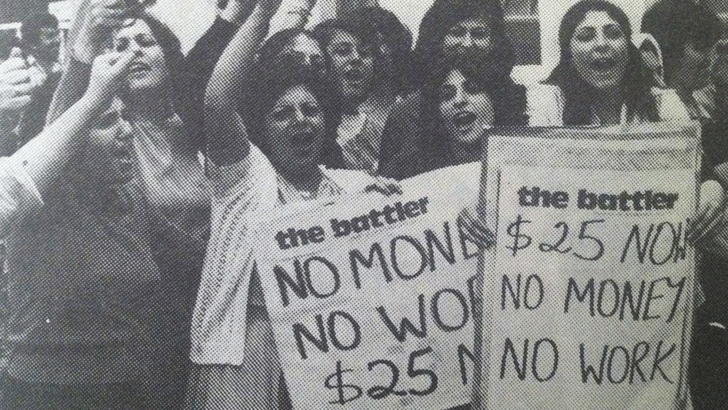Sweatshop rebels

In December 1981, 300 migrant women at the Kortex textile mill in Brunswick, Melbourne, were on strike for 10 days. They had to fight cops using batons and wearing guns; some were arrested. Men we called “the company goons” were employed by the bosses to bully them into submission. Their union officials worked with the bosses to defeat the strike.
And they won! As well as the pay rise they won, the women stopped work for a Xmas party. The bosses were so nervous, they didn’t say a word, and so the women had won a half-day holiday. Solidarity inside the factory was at an all-time high; some improvements were made in working conditions, and shop stewards were elected.
This relatively small struggle had a transformative effect on the women’s consciousness and also on that of their families. In the homes, the men took over child care, cooking and house duties to free the women to attend the pickets for long hours. On the pickets, they played a supportive role while the women organised and led all the activities.
This strike had a dramatic impact on me (a socialist for only two years). It confirmed the Marxist arguments I had heard: that women’s oppression and their exploitation as workers combine and interact. So class struggle opens the possibility to challenge sexist stereotypes.
The women had no history of militancy. The strike did not happen because of any perception of their oppression and exploitation, but was part of the general class struggle. One of the women had a husband working at Rowntrees, where a strike had won a pay rise; others had husbands involved in a long and bitter fight not long before at Ford. The printing shop next door was on strike.
There was an atmosphere that you could win wage rises – if you were prepared to fight. When the Textile Workers’ Union officials failed to show up for a meeting about a pay claim, the women were furious and walked out.
On the first day, they stopped trucks entering their factory, marched to another Kortex plant and brought all the workers there out on strike. They began to feel their collective strength. Now they talked of their oppression and super-exploitation, expressing bitterness at what they had endured for years. The log of demands they drew up revealed the shocking conditions in the factory.
They wanted an end to the compulsory “bonus” system, which meant the sack if you didn’t complete the extra work required to earn it; a canteen so they had somewhere decent to have lunch and tea breaks – of which they wanted more than one a day. They wanted the right to visit the toilet when they chose and without supervisors coming to drag them back to work after three minutes. Perhaps the most galling of all was the compulsory donations they had to make for the bosses’ birthdays. They wanted that stopped.
So after one day, it was no longer simply a fight over pay. One woman told me that no Australians worked there because “it’s not a factory, it’s a jail”. By their own activity, they had begun to see the world in a whole new light and their own position in it.
They quickly learnt how to make their pickets and activities effective. They were amazingly persuasive with women who had been intimidated into going to work. And they instinctively understood how to undermine their bosses’ morale. They would get women coming to the picket to pretend to go towards the gate, then a group would go and speak to them in Turkish, bringing them to the picket as if another group had been convinced not to go in.
When the union officials called a mass meeting at Trades Hall to which the bosses brought women from other plants who weren’t even on strike, the women fought and won. With leaflets in several languages and their enthusiasm, they generated an electric atmosphere which terrified the bosses. They could see the other women might be won over, so they hustled them back onto the buses without a vote. But it was clear a second meeting would be decisive.
The air was stifling as hundreds crowded the corridors of Trades Hall, fighting, shouting, chanting. During the bedlam, some men supporting the strike attacked the goons. But the women pushed them aside, yelling: “Get out of the way, let us at them – we’ll kill them!” and using their shoes to take some revenge on their hated employers and their hired thugs. One of the bosses went off trailing blood from his nose, and the picketers managed to steal one of the bosses’ megaphones!
Sultan, one of a small number of members of the revolutionary Victorian Turkish Labourers’ Association who played an important political role, was important as a trusted translator. The vote was 365 for staying out, 362 to go back – out of a meeting of no more than 500! The officials had set it up, trying to stop strikers voting, so they had to accept the vote.
Driving back to the picket, we learnt that the young women – some as young as 16 – had fought their way in and voted up to 10 times. When we laughed, they simply replied: “Some of the older women could not get ballot papers, so we had to vote for them.”
It was a farce, but the strike had been saved by the sheer strength and determination of these young women.
The Kortex strike was living proof that in the class struggle sexist gender stereotypes can be challenged, changing the consciousness of women themselves, but also men’s attitudes. I concluded that if a small struggle could have such an effect on them and their families, it is easy to imagine women playing a leading role as leaders of broader class struggles, and winning their liberation by their own conscious activity.